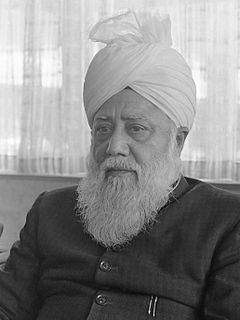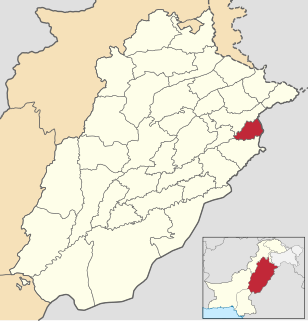
The Lahore Ahmadiyya Movement for the Propagation of Islam, is a separatist group within the Ahmadiyya movement that formed in 1914 as a result of ideological and administrative differences following the demise of Hakim Nur-ud-Din, the first Caliph after Mirza Ghulam Ahmad. Members of the Lahore Ahmadiyya movement are referred to by the majority group as ghayr mubāyi'īn and are also known colloquially as Lahori Ahmadis.

Berlin Mosque in Berlin is situated on Brienner Straße 7-8 in Berlin-Wilmersdorf. It was designed by K. A. Hermann and was built between 1923 and 1925. Berlin Mosque, which has two 90 feet (27 m) tall minarets, was heavily damaged in World War II. The two minarets were rebuilt in 1999/2001.

Hāfiz Mirza Nasir Ahmad was the third caliph, head of the Ahmadiyya Community. He was elected as the third successor of Mirza Ghulam Ahmad on 8 November 1965, the day after the death of his predecessor and father, Mirza Basheer-ud-Din Mahmood Ahmad.

Hakeem Noor-ud-Din was a close companion of Mirza Ghulam Ahmad, the founder of the Ahmadiyya Movement, and was chosen as his first successor on 27 May 1908, a day after his death, becoming the first caliph and leader of the worldwide Ahmadiyya Muslim Community. He was a renowned physician, writer, theologian, and an expert in Arabic and Hebrew.

The Fazl mosque also known as The London mosque, is the first purpose-built mosque in London, England. It was opened on 23 October 1926 in Southfields, Wandsworth. At a cost of £6,223, the construction of the place and the purchase of the land on which it stands, was financed by the donations of Muslims with support from the British Muslim convert Khalid Sheldrake. Between 1984 and 2019 the Fazl Mosque was the residence of the caliphs of the Ahmadiyya Muslim Community, and therefore its de facto international headquarters. The administrative headquarters now lies at the site of the Islamabad, Tilford.

Mirza Masroor Ahmad is the current and fifth leader of the Ahmadiyya Muslim Community. His official title within the movement is Fifth Caliph of the Messiah. He was elected on 22 April 2003, three days after the death of his predecessor Mirza Tahir Ahmad.

Khwaja Kamal-ud-Din was a prominent figure of the early Ahmadiyya movement and the author of numerous works on about Islam.

Malfūzāt is a ten-volume collection comprising the discourses, question-and-answer-sessions, sermons and dialogues of Mirza Ghulam Ahmad, the founder of the Ahmadiyya movement. The volumes contain, for the most part, speech that was transcribed by several of Ghulam Ahmad's close disciples as it was being communicated and was published in Ahmadi periodicals during his lifetime, covering a period starting from 1891 until his death in 1908. This material was compiled and published as a set of volumes during the 1960s.

The Ahmadiyya branch of Islam has been subject to various forms of religious persecution and discrimination since the movement's inception in 1889. The Ahmadiyya Muslim movement emerged from the Sunni tradition of Islam and its adherents believe in all the five pillars and articles of faith required of Muslims. Ahmadis are considered non-Muslims by many mainstream Muslims since they consider Mirza Ghulam Ahmad, the founder of the movement, to be the promised Mahdi and Messiah awaited by the Muslims.

Khadija Mosque is a mosque located in Heinersdorf, Pankow, Berlin. It is the property of the Ahmadiyya Muslim Community, and the first mosque in the former East Germany, opening on October 16, 2008. The mosque has a 39 feet (12 m) high minaret and can hold 500 worshippers. The mosque was financed by funds collected by Ahmadiyya women and the design was done by the architect Mubashra Ilyas.
Al-Ahmadiyah Madrasa is a madrasah complex in old Aleppo, Syria.

Islam is a minority religion in the island nation Tuvalu. With the introduction of Ahmadiyya Islam in 1985 by Ahmadi Muslims, there are approximately 50 Ahmadi Muslims in the country, of which all are members of the Ahmadiyya movement. Due to the country's small population, this represents 0.5% of Tuvalu. The Tuvalu Mosque, in Funafuti, the capital of Tuvalu, is the only mosque in the country.

Ahmadiyya, officially the Ahmadiyya Muslim Community or the Ahmadiyya Muslim Jama'at, is an Islamic revival or messianic movement originating in Punjab, British India, in the late 19th century. It was founded by Mirza Ghulam Ahmad (1835–1908), who claimed to have been divinely appointed as both the Promised Mahdi and Messiah expected by Muslims to appear towards the end times and bring about, by peaceful means, the final triumph of Islam; as well as to embody, in this capacity, the expected eschatological figure of other major religious traditions. Adherents of the Ahmadiyya—a term adopted expressly in reference to Muhammad's alternative name Aḥmad—are known as Ahmadi Muslims or simply Ahmadis.

The Lahore riots of 1953 were a series of violent riots against the Ahmadiyya Movement, a faith marginalized in Pakistan, mainly in the city of Lahore, Pakistan as well as the rest of Punjab, which were eventually quelled by the Pakistan Army who declared three months of martial law. The demonstrations began in February 1953, soon escalating into citywide incidents, including looting, arson and the murder of somewhere between 200 to 2000 people, while thousands more were left displaced. According to the official inquiry conducted by the Punjab Government the actual number killed in these riots were around 20 people. The page one of the inquiry says "Before the declaration of Martial Law, the police had to resort to firing in several places and at least two persons were killed on the night of 4th March and ten on 5th March, Sixty-six persons more must have been injured in the firing because that number of wounded persons admitted to the Lahore hospitals had gunshot wounds. The number of casualties admitted by the military to have been caused in quelling the disturbances in Lahore was eleven killed and forty-nine wounded. In some other towns also there were a number of casualties caused by firing by the police or the military.". Official Unable to contain the increasingly widespread civil disorder, Governor-General Ghulam Muhammad handed over the administration of the city to the army under Lieutenant General Azam Khan, imposing martial law on 6 March.

The Review of Religions is an English-language comparative religious magazine published monthly by the Ahmadiyya Muslim Community. Regularly in print since 1902, it is one of the longest running Islamic periodicals in English. It has been described as the main publication of the Ahmadiyya movement in the language and as a valuable source material for information on the geographical expansion of Ahmadi activity. The magazine was launched by Mirza Ghulam Ahmad with the aim of conveying an accurate understanding of Islamic teachings across the English-speaking world and dispelling misconceptions held against the faith. The articles, however, typically comprise distinctly Ahmadi perspectives. In addition to the English edition published from London, the magazine currently publishes separate quarterly editions in German, French and Spanish.

The May 2010 Lahore attacks, also referred to as the Lahore massacre, occurred on 28 May 2010, in Lahore, Punjab, Pakistan, during Friday prayers. 94 people were killed and more than 120 others were injured in nearly simultaneous attacks against two mosques of the minority Ahmadiyya muslim community. After the initial attack, a hostage situation lasted for hours. Tehrik-i-Taliban Pakistan, as well as their Punjab wing, claimed responsibility for the attacks and were also blamed by the Pakistani Police.

Ahmadiyya is an Islamic branch in Indonesia. The earliest history of the community in Indonesia dates back to the early days of the Second Caliph, when during the summer of 1925, roughly two decades prior to the Indonesian revolution, a missionary of the Community, Rahmat Ali, stepped on Indonesia's largest island, Sumatra, and established the movement with 13 devotees in Tapaktuan, in the province of Aceh. The Community has an influential history in Indonesia's religious development, yet in the modern times it has faced increasing intolerance from religious establishments in the country and physical hostilities from radical Muslim groups. The Association of Religion Data Archives estimates around 400,000 Ahmadi Muslims, spread over 542 branches across the country.

The timeline of Ahmadiyya history began in 1889 when the Ahmadiyya Muslim Community was established in Qadian, a village of India. It is now a worldwide community consisting of members from over 200 nations.

Ahmadiyya is an Islamic movement in Australia, first formally founded in the country in the 1980s, during the era of the fourth caliph. However, the history of the Community dates back to the early 20th century, during the lifetime of the founder of the movement, Mirza Ghulam Ahmad, with the first contacts arising as a consequence of Australians travelling to British India, and also as a consequence of early, "Afghan" camel drivers settling in Australia during the mid to late 19th century. Today there are at least four Ahmadi mosques in four of the six Australian states, representing an estimated 6,000-8,000 Australian Ahmadis in the country.

Ahmadiyya is an Islamic religious community in Singapore. The Community was established during the era of the Second Caliphate, shortly before the Second World War. Ghulam Hussain Ayyaz was the first missionary sent to the region, who under the direction of the caliph, arrived in 1935, in a period when the territory was part of the Straits Settlements. In the 1970s, the Community had roughly 200 followers, represented by 1-2% of the Muslim population.















